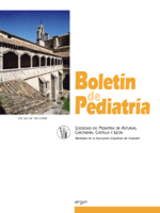Tabaquismo pasivo y asma infantil
A. Romo Melgar , V. Salazar Alonso-Villalobos , M.D. Melgar del Arco , A. Romo Cortina
Bol. Pediatr. 2005; 45 (193): 185 - 191
El humo ambiental del tabaco es un riesgo significativo para la salud de los niños pequeños. Se pretende estudiar el papel del tabaquismo pasivo en el padecimiento de asma en niños expuestos al mismo. Material y métodos: Se realiza un estudio retrospectivo de casos y controles apareados en 835 niños, distribuidos por grupos de edad y sexo. Se elige de forma aleatoria un control por cada caso, realizándose el apareamiento de 482 niños. Se analizan los siguientes factores: convivencia con fumadores, cohabitación con una madre fumadora habitual, presencia de fumadores en el domicilio durante la gestación y tabaquismo materno durante la misma. Los datos se organizan en tablas tetracóricas. Se realiza el test ?2 de Mantel-Haenszel. Se calcula la odds ratio, con intervalo de confianza del 95% y la fracción etiológica del riesgo para cada una de ellas. Resultados: El estudio no demuestra asociación significativa entre presencia habitual de fumadores en el domicilio y mayor frecuencia de asma infantil. En cambio, tener una madre fumadora habitual ?especialmente si fuma durante la gestación? y la convivencia de aquélla con fumadores en ese período, sí se asocia significativamente con tal patología. Conclusión: Nuestro estudio pone de manifiesto el riesgo que supone la exposición al humo del tabaco para el desarrollo del asma infantil, determinando una mayor prevalencia de asma en los hijos de mujeres fumadoras ?sobre todo si fumaron durante la gestación? y quizás coadyuvando para desencadenar obstrucción bronquial en los que se expusieron al tabaquismo de otras personas en ese período. Abstract Environmental tobacco smoke represents a significant risk for children health. The role of passive smoking habit in exposed children suffering from asthma is to be studied. Patients and methods: A retrospective matched casecontrol study is conducted in 835 children, who are distributed in groups according to their age and sex. Acontrol is randomly chosen per each case, thus matching 482 children. The following factors were analyzed: living with smokers, living with an usual smoking mother, usual presence of smokers at home during pregnancy, and maternal smoking habit during pregnancy. Data are arranged in 2x2 tables. ?2 Mantel-Haenszel test is conducted. Odds ratio, with a 95% confidence interval, and ethiological risk fraction are calculated for each one of the studied factors. Results: Our study does not show significant association between usual presence of smokers at home and higher childhood asthma frequency. However, having an usual smoking mother ?specially if she smokes during pregnancy? and her living with smokers during this period, do associate significantly with this pathology. Conclusions: Our study reveals the risk that implies the exposure to tobacco smoke for the development of childhood asthma, demonstrating a higher prevalence of asthma in children of smoking mothers ?particularly if they smoked during pregnancy? and perhaps contributing to trigger bronchial obstruction in those who were exposed to other people smoking habit during that period.
\N
\N
Artículo completo (PDF) (84 kb.)
- Neumología
Buscar en el boletín
Año 2005, Volumen 45, Número 193

Boletín completo en PDF (497 kb.)